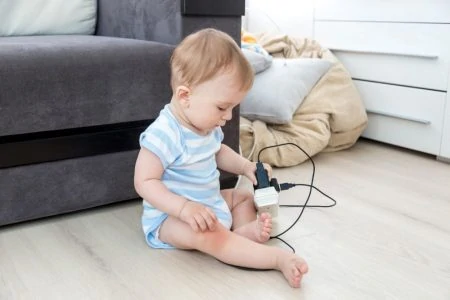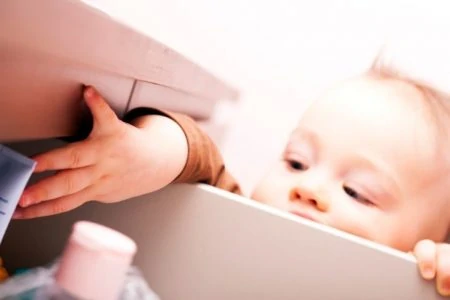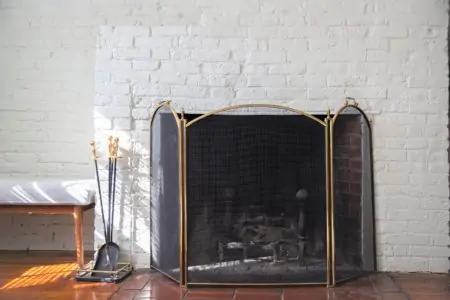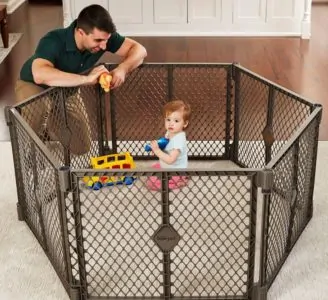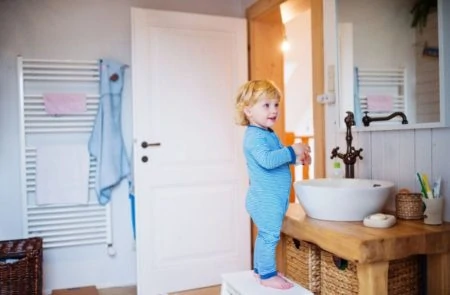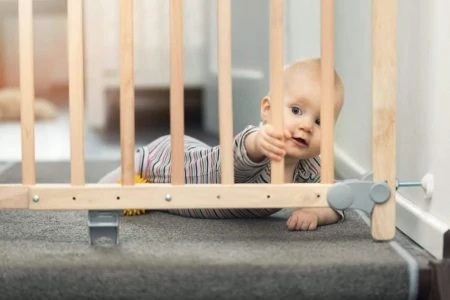Electricity is a modern necessity, but it is also one of the scariest hazards for a curious baby. One minute they are crawling, and the next, they are making a beeline for that fascinating holes-in-the-wall.
Babyproofing can feel overwhelming, especially when you realize just how many cords and sockets are at eye level for your little one. It is easy to miss a spot, but we are here to help you lock down your home.
In this guide, we will break down exactly how to babyproof electrical outlets and cords. From choosing the right covers for your lifestyle to managing that tangle of wires behind the TV, we have you covered.
Key Takeaways
- Use sliding outlet covers or box covers for the most secure protection against little fingers.
- Hide and shorten long electrical cords using tracks, sleeves, or furniture barriers to prevent strangulation or tripping.
- Secure power strips with specific covers so children cannot toggle switches or unplug devices.
- Teach toddlers early on that outlets are “ouch” and establish strict rules about not touching appliances.
How To Babyproof Electrical Outlets
Before you buy a cart full of plastic caps, it helps to understand what you are working with. The dangers are real; the U.S. Consumer Product Safety Commission estimates that thousands of children visit emergency rooms annually due to electrical socket injuries (1).
Most injuries happen when children stick metal objects (like keys or hairpins) or their fingers into the slots. Here is a quick breakdown of the outlets in your home and how to make them safe.
Types of Electrical Outlets
While there are many plug types globally, U.S. homes generally use Type A (two-prong) and Type B (three-prong). However, for safety purposes, you really need to know about the safety features built into modern receptacles.
1. GFCI Outlets
You will usually find Ground-Fault Circuit Interrupter (GFCI) outlets in bathrooms, kitchens, and laundry rooms. They are designed to cut the power instantly if they detect an interruption in the current, such as an appliance falling into water.
Look for the “Test” and “Reset” buttons in the middle of the plate. While these protect against shock from water, they do not inherently stop a child from sticking something into the slots. You still need to cover them.
2. AFCI Outlets
Arc Fault Circuit Interrupter (AFCI) outlets help prevent electrical fires. They detect dangerous arcing (sparking) conditions that can happen with damaged wires. Like GFCIs, these are great for fire safety but do not prevent a child from accessing the electricity.
3. Tamper-Resistant Receptacles (TRRs)
If your home was built or renovated recently, you might already have these. TRRs look like standard outlets but have built-in internal shutters. These shutters remain closed unless two prongs are inserted simultaneously with equal pressure.
This means a toddler poking a single paperclip into one slot will not make contact with the electricity. If you have these, you may not need external covers, but many parents still use them for peace of mind.
Types Of Electrical Outlet Covers
The easiest way to stop a shock is to block the access point. However, not all covers are created equal. Some are better for outlets you use daily, while others are best for unused plugs behind the sofa.
1. Plastic Outlet Covers

These are the classic, inexpensive plastic caps you stick directly into the socket. They sit flush against the outlet faceplate, making it difficult for a child to get a grip and pull them out.
Why buy these? They are the most budget-friendly option for “locking down” a house quickly. If you are renting or visiting grandparents, these are perfect because they require no installation tools. However, be warned: determined toddlers can eventually learn to pry them off. Once removed, the small cap becomes a high-risk choking hazard.
- Pros: Very cheap, easy to install instantly, and great for travel or rental properties.
- Cons: Can be a choking hazard if removed by a child; easy for adults to lose; annoying to remove every time you need to vacuum.
2. Outlet Boxes

An outlet box is a large cover that goes over the entire faceplate, enclosing the plugs and the cords. These usually require you to unscrew your existing faceplate and screw the box into place.
Why buy these? These are essential for outlets that are permanently in use. Think about the nursery monitor, the TV, or a lamp in the play area. Standard plastic caps cannot help you here because the outlet is occupied. A box cover stops your child from unplugging the device or playing with the partially exposed prongs.
- Pros: Best for items that stay plugged in; prevents children from unplugging essential devices; hides the cord head.
- Cons: Bulky and visually intrusive; won’t fit behind furniture that sits flush against the wall.
3. Self-Closing Outlet Covers

Also known as sliding plate covers, these replace your existing outlet faceplate entirely. When you pull a plug out, a spring-loaded mechanism slides a solid plastic cover over the holes immediately.
Why buy these? This is the best permanent solution for homeowners. You never have to worry about losing a plastic cap or remembering to put it back in. It is automatic safety. To use the outlet, you simply slide the cover over, insert your plug, and you are good to go.
- Pros: Aesthetically pleasing; impossible for a child to remove (since it is screwed in); zero choking hazard risk; automatic protection.
- Cons: Requires installation with a screwdriver; slightly more expensive than plastic caps; changing them out can be time-consuming if you have a large house.
Remember
How To Babyproof Electrical Cords
Focusing on the outlets is only half the battle. The cords themselves are a strangulation risk, a tripping hazard, and a chew toy all in one.
Loose cords are dangerous because kids can:
- Pull a heavy lamp or TV down onto themselves.
- Wrap the cord around their neck.
- Chew through the insulation and suffer severe electrical burns.
- Trip while running.
Here is how to tame the wire jungle in five steps.
1. Evaluate Exposed Outlets
The best defense is a good offense. If you can hide the outlet and the cord entirely behind a heavy piece of furniture, do it.
Push bookcases, dressers, or sofas in front of the most chaotic wire clusters. Just remember to anchor that furniture to the wall so it doesn’t tip over if your child tries to climb it to get behind.
2. Use a Cord Shortener

Long cords are tempting “ropes” for children. If you have a lamp cord that is three feet too long, use a cord shortener.
These devices, sometimes called cable turtles, allow you to wind the excess slack inside a protective shell. This keeps the cord taut and removes the loop that children could get tangled in.
3. Strap Cords to the Floor or Wall
For cords that must run across a walkway or along a baseboard, you need to lock them down.
Duct cord covers or on-floor cable protectors are rubber strips that sit over the wire. They prevent tripping and stop little hands from picking up the wire to chew on it. For walls, use adhesive clips to pin the wire tight against the wall so it cannot be pulled away.
4. Wrap Cords Together

Computer desks and entertainment centers are usually a disaster zone of tangled wires. This is a magnet for babies.
Use a cord sleeve (a flexible tube that zips or wraps around a bundle of wires) to turn ten loose cords into one thick, manageable tube. This is much harder for a child to grab or separate, and it looks significantly neater.
5. Cord Protectors

If you have a pet or a child who is prone to chewing, clear plastic tubing (critter cords) creates a barrier infused with citrus or bitter apple scent to deter chewing. Even if they do bite, the thick plastic protects the live wire underneath.
How To Babyproof Power Strips

Power strips are incredibly attractive to toddlers because they often have a glowing red on/off switch that looks just like a toy.
To fix this, get a power strip cover. These look like large Tupperware containers that slide over the entire strip. They have slots for the cords to exit, but the box itself locks, preventing your child from pulling plugs out or toggling the power switch.
If a full cover won’t fit your space, at least use individual plastic caps for the unused sockets on the strip and tape over the power switch with heavy-duty tape.
Teach Your Children To Use Electricity Safely
Hardware is helpful, but education is permanent. As your child moves from toddlerhood to preschool age, you need to teach them respect for electricity.
Here are practical rules to implement in your home:
For Parents:
- Model good behavior: Do not yank cords from the wall or use frayed wires.
- Remove temptation: Never place stickers or colorful decorations around outlets.
- Unplug appliances: Keep hair dryers, toasters, and heaters unplugged and stored away when not in use.
- Supervision: Watch your child closely in new environments (like hotels) that may not be babyproofed.
For Children:
- No water: Teach them that electronics and water (baths, sinks, drinks) never mix.
- Ask for help: Make a rule that only “big people” are allowed to plug things in.
- The “Ouch” rule: Reinforce that outlets are dangerous and can hurt them.
Pro Tip
